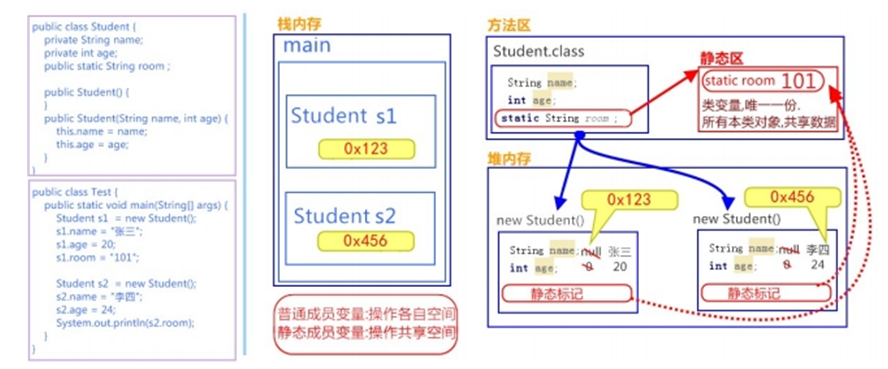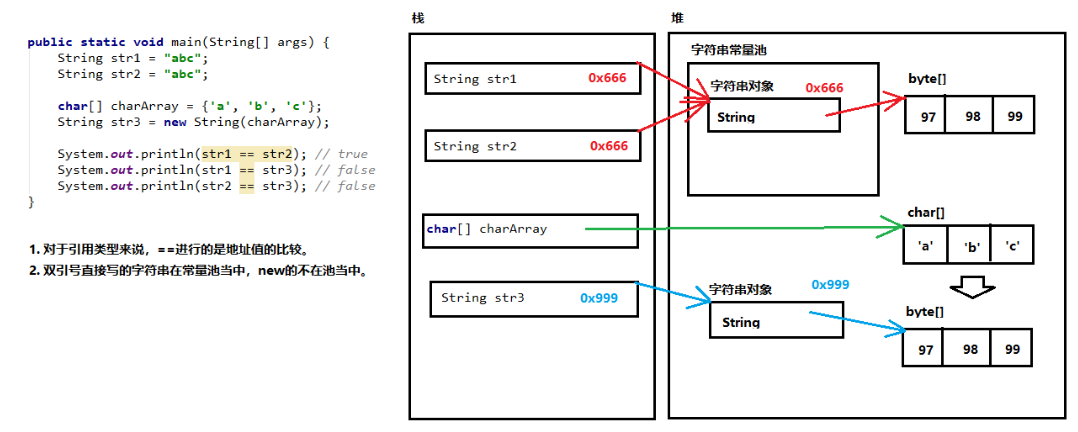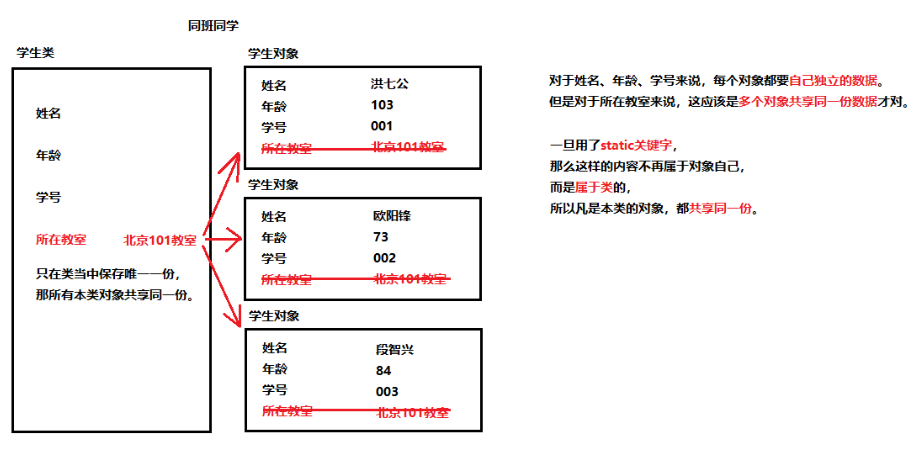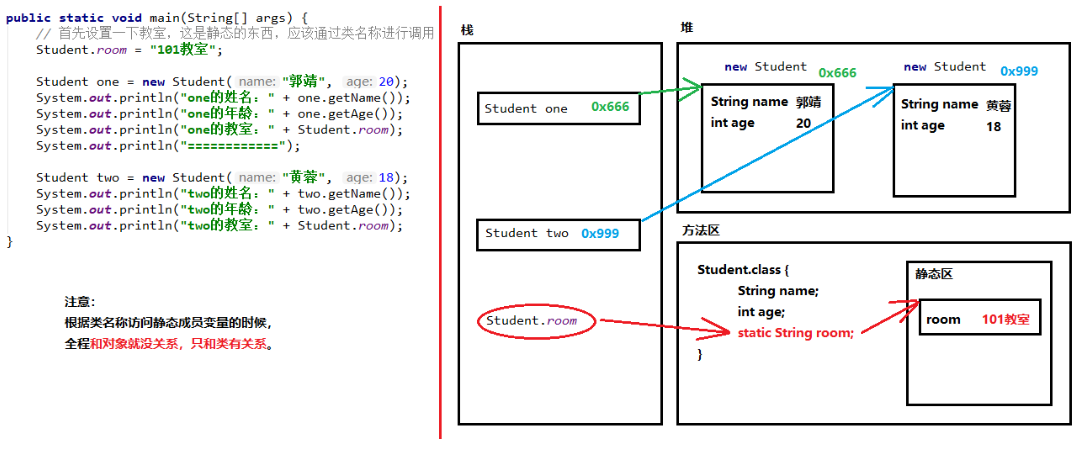day08【String类、static关键字、Arrays类、 Math类】
今日内容
String类
static关键字
Arrays类
Math类
教学目标
能够使用String类的构造方法创建字符串对象
能够明确String类的构造方法创建对象,和直接赋值创建字符串对象的区别
能够使用文档查询String类的判断方法
能够使用文档查询String类的获取方法
能够使用文档查询String类的转换方法
能够理解static关键字
能够写出静态代码块的格式
能够使用Arrays类操作数组
能够使用Math类进行数学运算
第一章String类
1.1String类概述
概述
java.lang.String 类代表字符串。Java程序中所有的字符串文字(例如 "abc" )都可以被看作是实现此类的实 例。
类 String 中包括用于检查各个字符串的方法,比如用于比较字符串,搜索字符串,提取子字符串以及创建具有翻 译为大写或小写的所有字符的字符串的副本。
特点
1. 字符串不变:字符串的值在创建后不能被更改。
String s1 = "abc"; s1 += "d"; System.out.println(s1); // "abcd" // 内存中有"abc","abcd"两个对象,s1从指向"abc",改变指向,指向了"abcd"。
2. 因为String对象是不可变的,所以它们可以被共享。
String s1 = "abc"; String s2 = "abc"; // 内存中只有一个"abc"对象被创建,同时被s1和s2共享。
3. "abc" 等效于 char[] data={ 'a' , 'b' , 'c' } 。
例如: String str = "abc"; 相当于: char data[] = {'a', 'b', 'c'}; String str = new String(data); // String底层是靠字符数组实现的。
1.2使用步骤
查看类
java.lang.String :此类不需要导入。
查看构造方法
public String() :初始化新创建的 String对象,以使其表示空字符序列。
public String(char[] value) :通过当前参数中的字符数组来构造新的String。
public String(byte[] bytes) :通过使用平台的默认字符集解码当前参数中的字节数组来构造新的 String。
构造举例,代码如下:
/ 无参构造 String str = new String(); // 通过字符数组构造 char chars[] = {'a', 'b', 'c'}; String str2 = new String(chars); // 通过字节数组构造 byte bytes[] = { 97, 98, 99 }; String str3 =
1.3常用方法
判断功能的方法
public boolean equals (Object anObject) :将此字符串与指定对象进行比较。
public boolean equalsIgnoreCase (String anotherString) :将此字符串与指定对象进行比较,忽略大小 写。
方法演示,代码如下:
public class String_Demo01 { public static void main(String[] args) { // 创建字符串对象 String s1 = "hello"; String s2 = "hello"; String s3 = "HELLO"; // boolean equals(Object obj):比较字符串的内容是否相同 System.out.println (s1.equals(s2)); // true System.out.println (s1.equals(s3)); // false System.out.println ("‐‐‐‐‐‐‐‐‐‐‐"); //boolean equalsIgnoreCase(String str):比较字符串的内容是否相同,忽略大小写 System.out.println (s1.equalsIgnoreCase(s2)); // true System.out.println (s1.equalsIgnoreCase(s3)); // true System.out.println ("‐‐‐‐‐‐‐‐‐‐‐"); } }
Object 是” 对象”的意思,也是一种引用类型。作为参数类型,表示任意对象都可以传递到方法中。
获取功能的方法
public int length () :返回此字符串的长度。
public String concat (String str) :将指定的字符串连接到该字符串的末尾。 public char charAt (int index) :返回指定索引处的 char值。
public int indexOf (String str) :返回指定子字符串第一次出现在该字符串内的索引。 public String substring (int beginIndex) :返回一个子字符串,从beginIndex开始截取字符串到字符 串结尾。
public String substring (int beginIndex, int endIndex) :返回一个子字符串,从beginIndex到 endIndex截取字符串。含beginIndex,不含endIndex。
方法演示,代码如下:
public class String_Demo02 { public static void main(String[] args) { //创建字符串对象 String s = "helloworld" ; // int length(): 获取字符串的长度,其实也就是字符个数 System.out.println (s.length()); System.out.println ("‐‐‐‐‐‐‐‐"); // String concat (String str):将将指定的字符串连接到该字符串的末尾. String s = "helloworld" ; String s2 = s.concat("**hello itheima"); System.out.println (s2);// helloworld**hello itheima // char charAt(int index):获取指定索引处的字符 System.out.println (s.charAt(0)); System.out.println (s.charAt(1)); System.out.println ("‐‐‐‐‐‐‐‐"); // int indexOf(String str):获取str在字符串对象中第一次出现的索引,没有返回‐1 System.out.println (s.indexOf ("l")); System.out.println (s.indexOf ("owo")); System.out.println (s.indexOf ("ak")); System.out.println ("‐‐‐‐‐‐‐‐"); // String substring(int start):从start开始截取字符串到字符串结尾 System.out.println (s.substring (0)); System.out.println (s.substring (5)); System.out.println ("‐‐‐‐‐‐‐‐"); // String substring(int start,int end):从start到end截取字符串。含start,不含end。 System.out.println (s.substring (0, s.length())); System.out.println (s.substring (3,8)); } }
转换功能的方法
public char[] toCharArray () :将此字符串转换为新的字符数组。 public byte[] getBytes () :使用平台的默认字符集将该 String编码转换为新的字节数组。 public String replace (CharSequence target, CharSequence replacement) :将与target匹配的字符串使 用replacement字符串替换。
方法演示,代码如下:
public class String_Demo03 { public static void main(String[] args) { //创建字符串对象 String s = "abcde"; // char[] toCharArray():把字符串转换为字符数组 char[] chs = s.toCharArray(); for(int x = 0; x < chs.length; x++) { System.out.println(chs[x]); } System.out.println ("‐‐‐‐‐‐‐‐‐‐‐"); // byte[] getBytes ():把字符串转换为字节数组 byte[] bytes = s.getBytes (); for(int x = 0; x < bytes.length; x++) { System.out.println(bytes[x]); } System.out.println ("‐‐‐‐‐‐‐‐‐‐‐"); // 替换字母it为大写IT String str = "itcast itheima" ; String replace = str.replace ("it", "IT"); System.out.println (replace ); // ITcast ITheima System.out.println ("‐‐‐‐‐‐‐‐‐‐‐"); } }
CharSequence 是一个接口,也是一种引用类型。作为参数类型,可以把String对象传递到方法中。
分割功能的方法
public String[] split(String regex) :将此字符串按照给定的regex(规则)拆分为字符串数组。 方法演示,代码如下:
public class String_Demo03 { public static void main(String[] args) { //创建字符串对象 String s = "aa|bb|cc"; String[] strArray = s.split("|"); // ["aa","bb","cc"] for(int x = 0; x < strArray.length; x++) { System.out.println(strArray[x]); // aa bb cc } }
1.4String类的练习
拼接字符串
定义一个方法,把数组{1,2,3}按照指定个格式拼接成一个字符串。格式参照如下[word1#word2#word3]。:
public class StringTest1 { public static void main(String[] args) { //定义一个int类型的数组 int[] arr = {1,2, 3}; //调用方法 String s = arrayToString(arr); //输出结果 System.out.println ("s:" + s); } /* * 写方法实现把数组中的元素按照指定的格式拼接成一个字符串 * 两个明确: * 返回值类型:String * 参数列表:int[] arr */ public static String arrayToString(int[] arr) { // 创建字符串s String s = new String("["); // 遍历数组,并拼接字符串 for (int x = 0;x < arr.length; x++) { if (x == arr.length ‐ 1) { s = s.concat(arr[x] + "]"); } else { s = s.concat(arr[x] + "#"); } } return s; } }
统计字符个数
键盘录入一个字符,统计字符串中大小写字母及数字字符个数
public class StringTest2 { public static void main(String[] args) { //键盘录入一个字符串数据 Scanner sc = new Scanner (System.in); System.out.println ("请输入一个字符串数据:"); String s = sc.nextLine(); //定义三个统计变量,初始化值都是0 int bigCount = 0; int smallCount = 0; int numberCount = 0; //遍历字符串,得到每一个字符 for(int x=0; x<s.length(); x++) { char ch = s.charAt(x); //拿字符进行判断 if(ch>='A'&&ch<='Z') { bigCount++; }else if(ch>='a'&&ch<='z') { smallCount++; }else if(ch>='0'&&ch<='9') { numberCount++; }else { System.out.println ("该字符"+ch+"非法"); } } //输出结果 System.out.println ("大写字符:"+bigCount+"个"); System.out.println ("小写字符:"+smallCount+"个"); System.out.println ("数字字符:"+numberCount+"个"); } }
第二章static关键字
2.1概述
关于 static 关键字的使用,它可以用来修饰的成员变量和成员方法,被修饰的成员是属于类的,而不是单单是属 于某个对象的。也就是说,既然属于类,就可以不靠创建对象来调用了。
2.2定义和使用格式
类变量
当 static 修饰成员变量时,该变量称为类变量。该类的每个对象都共享同一个类变量的值。任何对象都可以更改 该类变量的值,但也可以在不创建该类的对象的情况下对类变量进行操作。
类变量:使用 static关键字修饰的成员变量。
定义格式:
static 数据类型 变量名;
举例:
static int numberID;
比如说,基础班新班开班,学员报到。现在想为每一位新来报到的同学编学号(sid),从第一名同学开始,sid为 1,以此类推。学号必须是唯一的,连续的,并且与班级的人数相符,这样以便知道,要分配给下一名新同学的学 号是多少。这样我们就需要一个变量,与单独的每一个学生对象无关,而是与整个班级同学数量有关。
所以,我们可以这样定义一个静态变量numberOfStudent ,代码如下:
public class Student { private String name; private int age; // 学生的id private int sid; // 类变量,记录学生数量,分配学号 public static int numberOfStudent = 0; public Student(String name, int age){ this.name = name; this.age = age; // 通过 numberOfStudent 给学生分配学号 this.sid = ++numberOfStudent; } // 打印属性值 public void show() { System.out.println ("Student : name=" + name + ", age=" + age + ", sid=" + sid ); } } public class StuDemo { public static void main(String[] args) { Student s1 = new Student ("张三", 23); Student s2 = new Student ("李四", 24); Student s3 = new Student ("王五", 25); Student s4 = new Student ("赵六", 26); s1.show(); // Student : name=张三, age=23, sid=1 s2.show(); // Student : name=李四, age=24, sid=2 s3.show(); // Student : name=王五, age=25, sid=3 s4.show(); // Student : name=赵六, age=26, sid=4 } }
静态方法
当 static 修饰成员方法时,该方法称为类方法。静态方法在声明中有 static ,建议使用类名来调用,而不需要 创建类的对象。调用方式非常简单。
类方法:使用 static关键字修饰的成员方法,习惯称为静态方法。
定义格式:
修饰符 static 返回值类型 方法名 (参数列表){ // 执行语句 }
举例:在Student 类中定义静态方法
public static void showNum() { System.out.println ("num:" + numberOfStudent); }
静态方法调用的注意事项:
静态方法可以直接访问类变量和静态方法。
静态方法不能直接访问普通成员变量或成员方法。反之,成员方法可以直接访问类变量或静态方法。 静态方法中,不能使用this关键字。
小贴士:静态方法只能访问静态成员。
调用格式
被static修饰的成员可以并且建议通过类名直接访问。虽然也可以通过对象名访问静态成员,原因即多个对象均属 于一个类,共享使用同一个静态成员,但是不建议,会出现警告信息。
格式:
// 访问类变量 类名.类变量名; // 调用静态方法 类名.静态方法名(参数);
调用演示,代码如下:
public class StuDemo2 { public static void main(String[] args) { // 访问类变量 System.out.println (Student .numberOfStudent); // 调用静态方法 Student.showNum(); } }
2.3静态原理图解
static 修饰的内容:
是随着类的加载而加载的,且只加载一次。
存储于一块固定的内存区域(静态区),所以,可以直接被类名调用。 它优先于对象存在,所以,可以被所有对象共享。

2.4静态代码块
静态代码块:定义在成员位置,使用static修饰的代码块{ }。
位置:类中方法外。
执行:随着类的加载而执行且执行一次,优先于main方法和构造方法的执行。
格式:
public class ClassName{ static { // 执行语句 } }
作用:给类变量进行初始化赋值。用法演示,代码如下:
public class Game { public static int number; public static ArrayList<String> list; static { // 给类变量赋值 number = 2; list = new ArrayList<String>(); // 添加元素到集合中 list.add("张三"); list.add("李四"); } }
小贴士:
static 关键字,可以修饰变量、方法和代码块。在使用的过程中,其主要目的还是想在不创建对象的情况
下,去调用方法。下面将介绍两个工具类,来体现static 方法的便利。
第三章Arrays类
3.1概述
java.util.Arrays 此类包含用来操作数组的各种方法,比如排序和搜索等。其所有方法均为静态方法,调用起来 非常简单。
3.2操作数组的方法
public static String toString(int[] a) :返回指定数组内容的字符串表示形式。
public static void main(String[] args) { // 定义int 数组 int[] arr = {2,34,35,4,657,8,69,9}; // 打印数组,输出地址值 System.out.println (arr); // [I@2ac1fdc4 // 数组内容转为字符串 String s = Arrays.toString (arr); // 打印字符串,输出内容 System.out.println (s); // [2, 34, 35, 4, 657, 8, 69, 9] }
public static void sort(int[] a) :对指定的 int 型数组按数字升序进行排序。
public static void main(String[] args) { // 定义int 数组 int[] arr = {24, 7, 5, 48, 4, 46, 35, 11, 6, 2}; System.out.println ("排序前:"+ Arrays.toString (arr)); // 排序前:[24, 7, 5, 48, 4, 46, 35, 11, 6, 2] // 升序排序 Arrays.sort(arr); System.out.println ("排序后:"+ Arrays.toString (arr));// 排序后:[2, 4, 5, 6, 7, 11, 24, 35, 46, 48] }
3.3练习
请使用 Arrays 相关的API,将一个随机字符串中的所有字符升序排列,并倒序打印。
public class ArraysTest { public static void main(String[] args) { // 定义随机的字符串 String line = "ysKUreaytWTRHsgFdSAoidq"; // 转换为字符数组 char[] chars = line.toCharArray(); // 升序排序 Arrays.sort(chars); // 反向遍历打印 for (int i = chars.length‐1; i >= 0 ; i‐‐) { System.out.print(chars[i]+" "); // y y t s s r q o i g e d d a W U T S R K H F A } } }
第四章Math类
4.1概述
java.lang.Math 类包含用于执行基本数学运算的方法,如初等指数、对数、平方根和三角函数。类似这样的工具 类,其所有方法均为静态方法,并且不会创建对象,调用起来非常简单。
4.2基本运算的方法
public static double abs(double a) :返回 double 值的绝对值。
double d1 = Math.abs(‐5); //d1的值为5 double d2 = Math.abs(5); //d2的值为5
public static double ceil(double a) :返回大于等于参数的最小的整数。
double d1 = Math.ceil(3.3); //d1的值为 4.0 double d2 = Math.ceil(‐3.3); //d2的值为 ‐3.0 double d3 = Math.ceil(5.1); //d3的值为 6.0
public static double floor(double a) :返回小于等于参数最大的整数。
double d1 = Math.floor(3.3); //d1的值为3.0 double d2 = Math.floor(‐3.3); //d2的值为‐4.0 double d3 = Math.floor(5.1); //d3的值为 5.0
public static long round(double a) :返回最接近参数的 long。(相当于四舍五入方法)
long d1 = Math.round(5.5); //d1的值为6.0 long d2 = Math.round(5.4); //d2的值为5.0
4.3练习
请使用 Math 相关的API,计算在 -10.8 到 5.9 之间,绝对值大于 6 或者小于 2.1 的整数有多少个?
public class MathTest { public static void main(String[] args) { // 定义最小值 double min = ‐10.8; // 定义最大值 double max = 5.9; // 定义变量计数 int count = 0; // 范围内循环 for (double i = Math.ceil(min); i <= max; i++) { // 获取绝对值并判断 if (Math.abs(i) > 6 || Math.abs(i) < 2.1) { // 计数 count++; } } System.out.println ("个数为: " + count + " 个"); } }
一些分析图:
01-字符串的常量池

02-静态static关键字概述

03-静态的内存图

04-小学数学真题




